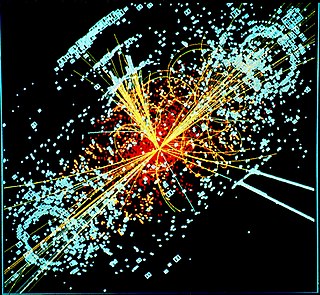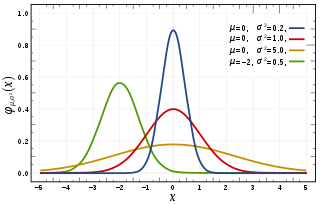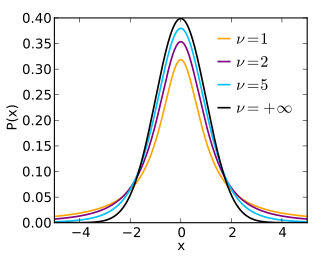In mathematics, the inverse limit is a construction that allows one to "glue together" several related objects, the precise manner of the gluing process being specified by morphisms between the objects. Inverse limits can be defined in any category, and they are a special case of the concept of a limit in category theory.

In physics, Kaluza–Klein theory is a classical unified field theory of gravitation and electromagnetism built around the idea of a fifth dimension beyond the usual four of space and time and considered an important precursor to string theory. Gunnar Nordström had an earlier, similar idea. But in that case, a fifth component was added to the electromagnetic vector potential, representing the Newtonian gravitational potential, and writing the Maxwell equations in five dimensions.

In probability theory, a normaldistribution is a type of continuous probability distribution for a real-valued random variable. The general form of its probability density function is
In mathematical analysis, the Haar measure assigns an "invariant volume" to subsets of locally compact topological groups, consequently defining an integral for functions on those groups.

The stress–energy tensor, sometimes called the stress–energy–momentum tensor or the energy–momentum tensor, is a tensor physical quantity that describes the density and flux of energy and momentum in spacetime, generalizing the stress tensor of Newtonian physics. It is an attribute of matter, radiation, and non-gravitational force fields. This density and flux of energy and momentum are the sources of the gravitational field in the Einstein field equations of general relativity, just as mass density is the source of such a field in Newtonian gravity.

In probability and statistics, Student's t-distribution is any member of a family of continuous probability distributions that arise when estimating the mean of a normally-distributed population in situations where the sample size is small and the population's standard deviation is unknown. It was developed by English statistician William Sealy Gosset under the pseudonym "Student".
In mathematics, the Kronecker delta is a function of two variables, usually just non-negative integers. The function is 1 if the variables are equal, and 0 otherwise:
In mathematics, the Radon–Nikodym theorem is a result in measure theory that expresses the relationship between two measures defined on the same measurable space. A measure is a set function that assigns a consistent magnitude to the measurable subsets of a measurable space. Examples of a measure include area and volume, where the subsets are sets of points; or the probability of an event, which is a subset of possible outcomes within a wider probability space.
A conformal field theory (CFT) is a quantum field theory that is invariant under conformal transformations. In two dimensions, there is an infinite-dimensional algebra of local conformal transformations, and conformal field theories can sometimes be exactly solved or classified.

In mathematics, mixing is an abstract concept originating from physics: the attempt to describe the irreversible thermodynamic process of mixing in the everyday world: mixing paint, mixing drinks, industrial mixing, etc.
In computability theory a numbering is the assignment of natural numbers to a set of objects such as functions, rational numbers, graphs, or words in some formal language. A numbering can be used to transfer the idea of computability and related concepts, which are originally defined on the natural numbers using computable functions, to these different types of objects.
In computability theory complete numberings are generalizations of Gödel numbering first introduced by A.I. Mal'tsev in 1963. They are studied because several important results like the Kleene's recursion theorem and Rice's theorem, which were originally proven for the Gödel-numbered set of computable functions, still hold for arbitrary sets with complete numberings.
In computability theory a cylindrification is a construction that associates a cylindric numbering to each numbering. The concept was first introduced by Yuri L. Ershov in 1973.
In computability theory two sets of natural numbers are computably isomorphic or recursively isomorphic if there exists a total bijective computable function with . By the Myhill isomorphism theorem, the relation of computable isomorphism coincides with the relation of mutual one-one reducibility.
In mathematics, ergodicity expresses the idea that a point of a moving system, either a dynamical system or a stochastic process, will eventually visit all parts of the space that the system moves in, in a uniform and random sense. This implies that the average behavior of the system can be deduced from the trajectory of a "typical" point. Equivalently, a sufficiently large collection of random samples from a process can represent the average statistical properties of the entire process. Ergodicity is a property of the system; it is a statement that the system cannot be reduced or factored into smaller components. Ergodic theory is the study of systems possessing ergodicity.
In measure theory, a radonifying function between measurable spaces is one that takes a cylinder set measure (CSM) on the first space to a true measure on the second space. It acquired its name because the pushforward measure on the second space was historically thought of as a Radon measure.
Alternatives to general relativity are physical theories that attempt to describe the phenomenon of gravitation in competition to Einstein's theory of general relativity. There have been many different attempts at constructing an ideal theory of gravity.
In measure theory, a discipline within mathematics, a pushforward measure is obtained by transferring a measure from one measurable space to another using a measurable function.
The table of chords, created by the Greek astronomer, geometer, and geographer Ptolemy in Egypt during the 2nd century AD, is a trigonometric table in Book I, chapter 11 of Ptolemy's Almagest, a treatise on mathematical astronomy. It is essentially equivalent to a table of values of the sine function. It was the earliest trigonometric table extensive enough for many practical purposes, including those of astronomy. Centuries passed before more extensive trigonometric tables were created. One such table is the Canon Sinuum created at the end of the 16th century.
Lagrangian field theory is a formalism in classical field theory. It is the field-theoretic analogue of Lagrangian mechanics. Lagrangian mechanics is used to analyze the motion of a system of discrete particles each with a finite number of degrees of freedom. Lagrangian field theory applies to continua and fields, which have an infinite number of degrees of freedom.












